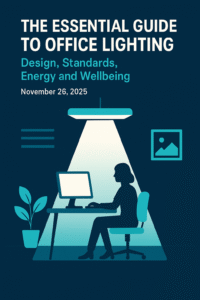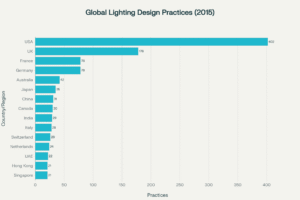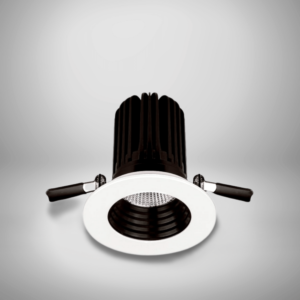Lighting accounts for nearly 5% of global CO2 emissions, underscoring the urgent need for more sustainable solutions. At Lumenloop, we are committed to leading this change through our circular economy approach to lighting.
Our mission is straightforward: to close the loop in the lighting sector. We’re leading the way in energy-efficient illumination, aiming for more than just power savings. By adopting circular principles, we’re eliminating waste, prolonging product lifetimes, and regenerating ecosystems.
Exploring circular economy lighting, we see it’s not just cutting our carbon footprint. It’s also opening up new avenues for businesses and consumers.
Understanding Circular Economy in the Lighting Industry
The lighting industry is undergoing a profound transformation, embracing the circular economy’s principles. This shift is redefining the design, production, and lifecycle management of led luminaires and other lighting products.
Defining the Circular Economy Concept
Those that adopt the circular economy aim to reduce waste and enhance resource efficiency. We advocate for products designed for longevity, repairability, and recyclability. This philosophy aligns with cradle-to-cradle design, ensuring materials are continuously reused or recycled, minimising environmental harm.
The Importance of Circularity in Lighting
Circularity in lighting transcends mere energy efficiency. It encompasses the entire lifecycle of lighting products, from raw material extraction to end-of-life management. By embracing circular practices, we can drastically cut waste, conserve resources, and diminish carbon emissions linked to lighting production and disposal.
Challenges and Opportunities
Adopting circular economy principles in lighting poses both challenges and opportunities. Overcoming existing manufacturing processes and altering industry mindsets are major obstacles. Despite these hurdles, the scope for innovation in product design, cost reductions, and environmental gains is vast.
| Challenges | Opportunities |
|---|---|
| Redesigning manufacturing processes | Innovation in product design |
| Changing industry mindsets | Reduced environmental impact |
| Developing new business models | Cost savings through resource efficiency |
| Establishing reverse logistics | Creation of remanufactured lighting products |
As we tackle these challenges, the prospects for sustainable, efficient, and innovative lighting solutions grow clearer. The rise of remanufactured lighting products and circular design strategies show us the way to a more sustainable future.
The Birth of TM66: Redefining Sustainable Lighting
In October 2021, the lighting industry marked a significant milestone with the release of TM66 by CIBSE and the Society of Light and Lighting. This document introduced a structured method for applying and assessing circular economy principles in lighting design and manufacturing.
TM66 addresses the urgent need for standardised circularity metrics in the lighting sector. It introduces the Circular Economy Assessment Methods (CEAM), a system that quantifies product circularity with a star rating. This method empowers lighting professionals to make sustainable product choices with confidence.
The creation of TM66 was a joint effort, involving industry volunteers who saw the value of circular economy practices in lighting. Their hard work has led to a tool that not only measures circularity but also motivates manufacturers to enhance their products’ sustainability.
“TM66 represents a significant step forward in our industry’s commitment to sustainability. It provides a common language for discussing and evaluating circular economy principles in lighting.” – Bernadette Pangilinan
The influence of TM66 goes beyond just assessing products. It acts as an educational tool, increasing awareness of circular economy concepts among lighting professionals, specifiers, and manufacturers. TM66’s clear framework for circularity is driving innovation and promoting sustainable practices in the lighting industry.
| TM66 Feature | Impact on Lighting Industry |
|---|---|
| Circular Economy Assessment Methods (CEAM) | Enables quantification of product circularity |
| Star Rating System | Facilitates easy comparison of product sustainability |
| Standardised Approach | Promotes consistency in circularity evaluation |
| Industry Collaboration | Ensures relevance and practicality of guidelines |
Circular Economy Lighting: Our Approach at Lumenloop
At Lumenloop, we’re dedicated to crafting sustainable lighting solutions that embody circular economy principles. Our strategy aims to minimise environmental harm while maximising product longevity and efficiency.
Design for Longevity and Repairability
We design our LED luminaires with longevity in mind. Every component is meticulously chosen for durability and simplicity in replacement. This strategy not only prolongs our products’ lifespan but also slashes waste and resource usage.
Material Selection and Recycling
Our dedication to sustainability is evident in our material choices. We favour recyclable materials in our intelligent lighting controls and fixtures. This decision makes end-of-life recycling simpler and supports the circular economy model.
Manufacturing Processes and Localisation
We’ve streamlined our manufacturing processes to lower energy consumption and waste. By producing locally, we significantly reduce transportation-related emissions. This strategy benefits the environment and supports local economies.
- Energy-efficient production methods
- Waste reduction strategies
- Local sourcing of materials where possible
Through these practices, we aim to close the loop in lighting production. Our objective is to develop sustainable lighting solutions that effectively illuminate spaces and contribute to a more circular and sustainable future.
TM66 CEAM-Make: Assessing Circularity in Lighting Products
TM66 CEAM-Make is a pioneering tool by CIBSE for evaluating circularity in lighting products. It’s a detailed system designed to help manufacturers and designers craft more eco-friendly lighting options. These align with the principles of the circular economy.
These categories are critical to understanding circular economy lighting. They include design for longevity, the use of recyclable materials, efficient manufacturing, and support services.
TM66 CEAM-Make allows us to assess various factors that enhance a product’s circularity. It provides a single-figure rating. This makes it straightforward to compare different lighting products and encourage better circular economy practices.
| Category | Aspects Evaluated |
|---|---|
| Product Design | Longevity, repairability, upgradability |
| Materials | Recycled content, recyclability, hazardous substances |
| Manufacturing | Energy efficiency, waste reduction, local sourcing |
| Ecosystem | Take-back schemes, maintenance services, product information |
TM66 CEAM-Make enables us to develop more sustainable lighting solutions. Not only does it encourage innovation but also propels the industry towards a circular future. By adopting this tool, we can greatly diminish waste and environmental harm in the lighting industry.
The Role of Specifiers in Driving Circular Economy Practices
Specifiers are at the forefront of driving circular economy practices in the lighting industry. Their choices shape the what it means to supply sustainable lighting solutions. They influence manufacturers to prioritise circularity in their products.
Using TM66 CEAM-Specify for Product Comparison
TM66 CEAM-Specify offers a streamlined version of the circular economy assessment method. This tool empowers specifiers to make quick comparisons between lighting products. It focuses on their circular performance.
The assessment considers factors such as material selection, repairability, and end-of-life management. This ensures that specifiers can make informed decisions when selecting lighting products for their projects.
Demanding Circularity Ratings in Projects
Without demands, we’ll never be in a position to supply circular solutions. This is why specifiers play such an important role in promoting circularity by incorporating circularity ratings into project requirements. This practice encourages manufacturers to improve their products’ circular performance. It drives industry-wide adoption of sustainable practices.
| Circularity Aspect | Impact on Specification |
|---|---|
| Material Selection | Preference for recyclable and recycled materials |
| Repairability | Emphasis on modular design for easy maintenance |
| Energy Efficiency | Focus on intelligent lighting controls for optimal performance |
| End-of-Life Management | Consideration of take-back schemes and recycling options |
By prioritising these aspects in their specifications, lighting professionals can significantly influence the adoption of lighting-as-a-service models. They push for more sustainable lighting solutions across the industry.
Beyond Energy Efficiency: The Holistic Approach to Sustainable Lighting
Sustainable lighting has moved beyond just focusing on energy savings. Today, we understand the need for a broader strategy. This includes the whole lifecycle of LED luminaires, from production to disposal. Our goal is to reduce environmental harm at every stage while equipping our projects with the most suitable products.
Embodied Carbon Considerations
In sustainable lighting design, embodied carbon is a critical factor. It encompasses emissions from manufacturing, transport, and installation of LED lights. By choosing materials and methods with lower carbon emissions, we can greatly lessen our environmental footprint.
Life Cycle Analysis in Lighting Design
Life Cycle Analysis (LCA) is essential in our design philosophy. It helps us evaluate the environmental effects of our lighting products from start to finish. By examining each phase, from raw material extraction to disposal, we pinpoint areas for enhancement. This leads to the creation of truly sustainable lighting.
The Future of Circular Economy Lighting: TM66 CEAM-Manage
The lighting industry is rapidly evolving, with a focus on sustainable solutions. TM66 CEAM-Manage is at the forefront, aiming for long-term sustainability in facilities management.
Long-term Sustainability in Facilities Management
TM66 CEAM-Manage is poised to transform facilities management for sustainable lighting systems. It builds upon CEAM-Make and CEAM-Specify, forming a complete circular economy lifecycle approach.
Intelligent lighting controls are key in this new era. They optimise energy use and prolong lighting fixture life, embodying circular economy ideals.
Extending TM66's Influence to Other Building Services
TM66’s success in lighting sets the stage for its application in other building services. This could greatly enhance sustainability in the built environment.
Lighting-as-a-service models are becoming popular, providing a flexible, sustainable lighting solution. This shift from owning products to services reduces waste and boosts resource efficiency.
| Building Service | Potential TM66 Application | Sustainability Impact |
|---|---|---|
| HVAC Systems | Energy-efficient design and lifecycle management | Reduced energy consumption and extended equipment life |
| Plumbing | Water conservation and sustainable material use | Lower water waste and increased use of recyclable materials |
| Electrical Systems | Smart grid integration and renewable energy adoption | Improved energy efficiency and reduced carbon footprint |
Looking ahead, TM66 CEAM-Manage will significantly influence sustainable lighting and broader building services management.
Conclusion: Embracing Circularity for a Sustainable Future in Lighting
The lighting industry is at a critical juncture, with circular economy principles guiding the way. We’ve seen how sustainable lighting solutions can transform our approach to lighting, cutting down on waste and environmental harm. TM66 has been a game-changer, enabling manufacturers, specifiers, and users to evaluate and boost the circularity of lighting products.
Adopting circular economy lighting practices goes beyond creating energy-efficient lighting. It encourages innovation and extends product lifespan. This move towards circularity benefits both businesses and the environment, setting the stage for a greener future in lighting.
It’s now clear that embracing circular principles is not just a choice—it’s a necessity. The lighting industry can set an example, demonstrating how sustainable practices can benefit both the planet and the economy. By working together, we can create a brighter, more sustainable future for all.
FAQ
What is the circular economy concept in lighting?
The circular economy in lighting focuses on reducing waste and boosting resource efficiency. It encourages the creation of products that last longer, can be repaired, and recycled. This approach aims to lessen environmental harm and foster sustainability throughout a product’s life cycle.
What is TM66 and its significance?
TM66 is a Technical Memorandum by CIBSE and the Society of Light and Lighting. It outlines a method for applying and assessing circular economy principles in lighting. The Circular Economy Assessment Methods (CEAM) within TM66 use a star rating system to measure product circularity.
How does Lumenloop implement circular economy principles?
At Lumenloop, we adhere to circular economy principles in our design and manufacturing. We focus on creating products that are durable and can be repaired. We also select materials that are recyclable and manufacture locally to cut down on transportation emissions.
What is TM66 CEAM-Make?
TM66 CEAM-Make is a detailed assessment tool with 72 questions across four areas: Product Design, Materials, Manufacturing, and Ecosystem. It evaluates design for longevity, material recyclability, manufacturing methods, and support services. It offers a single-figure rating for easy product comparison.
How can specifiers promote circular economy practices?
Specifiers are key in driving circular economy practices by demanding circularity ratings. TM66 CEAM-Specify provides a simplified version for quick comparisons. By incorporating circularity criteria into specifications, lighting professionals can encourage the adoption of sustainable practices across the industry.
What is the holistic approach to sustainable lighting?
Sustainable lighting encompasses more than just energy efficiency. It considers embodied carbon and lifecycle impacts. This approach involves evaluating material environmental impact, manufacturing processes, transportation, and end-of-life handling. Life Cycle Analysis (LCA) is used to identify areas for improvement throughout a product’s lifecycle.
What is TM66 CEAM-Manage and its purpose?
TM66 CEAM-Manage is being developed to assist Facilities Managers in sustaining lighting systems over time. It complements CEAM-Make and CEAM-Specify, forming a complete framework for circular economy practices across a product’s lifecycle.
Can you provide examples of successful circular economy lighting projects?
The Hope Sculpture in Glasgow, designed for COP26, was the first to use TM66. It featured Stoane Lighting’s Tadpole spotlight with an ‘excellent circularity’ score. The Time on Earth exhibition at the Barbican Centre used ZTA spotlights, demonstrating the practical application of circular economy principles in prominent lighting projects.












